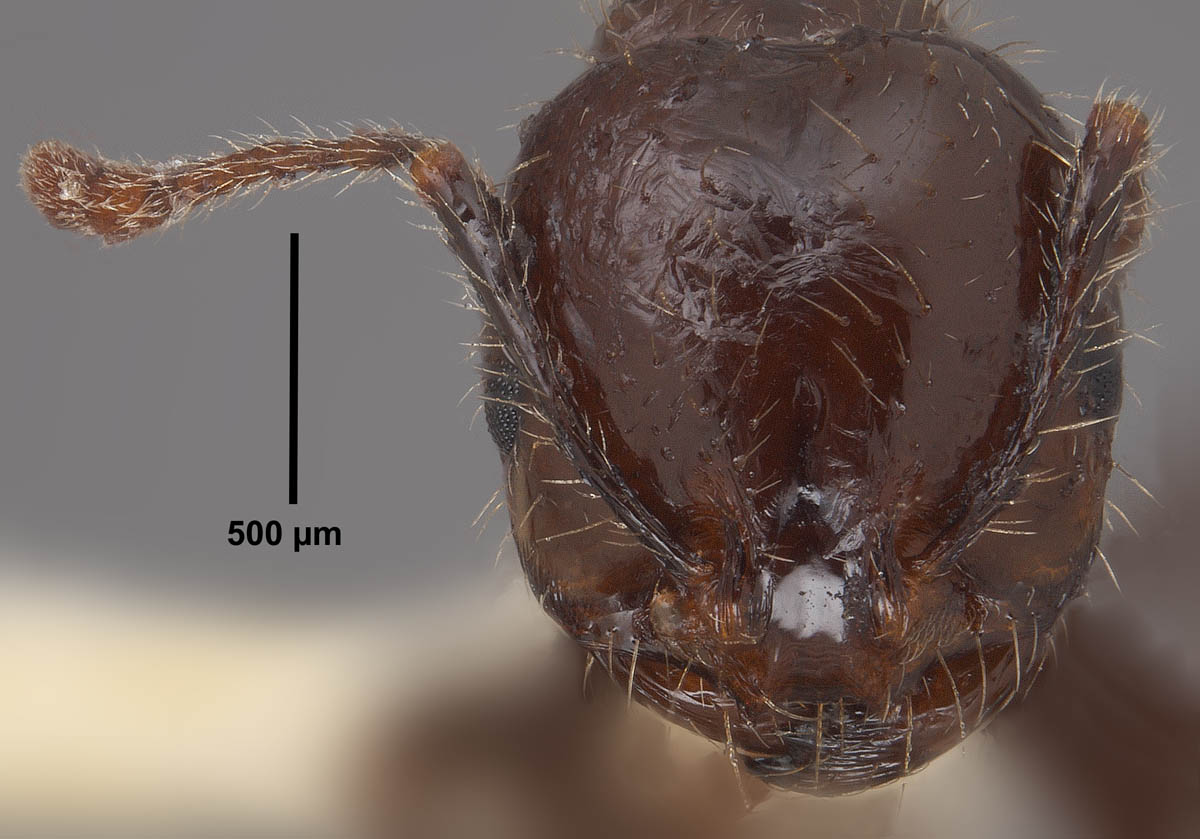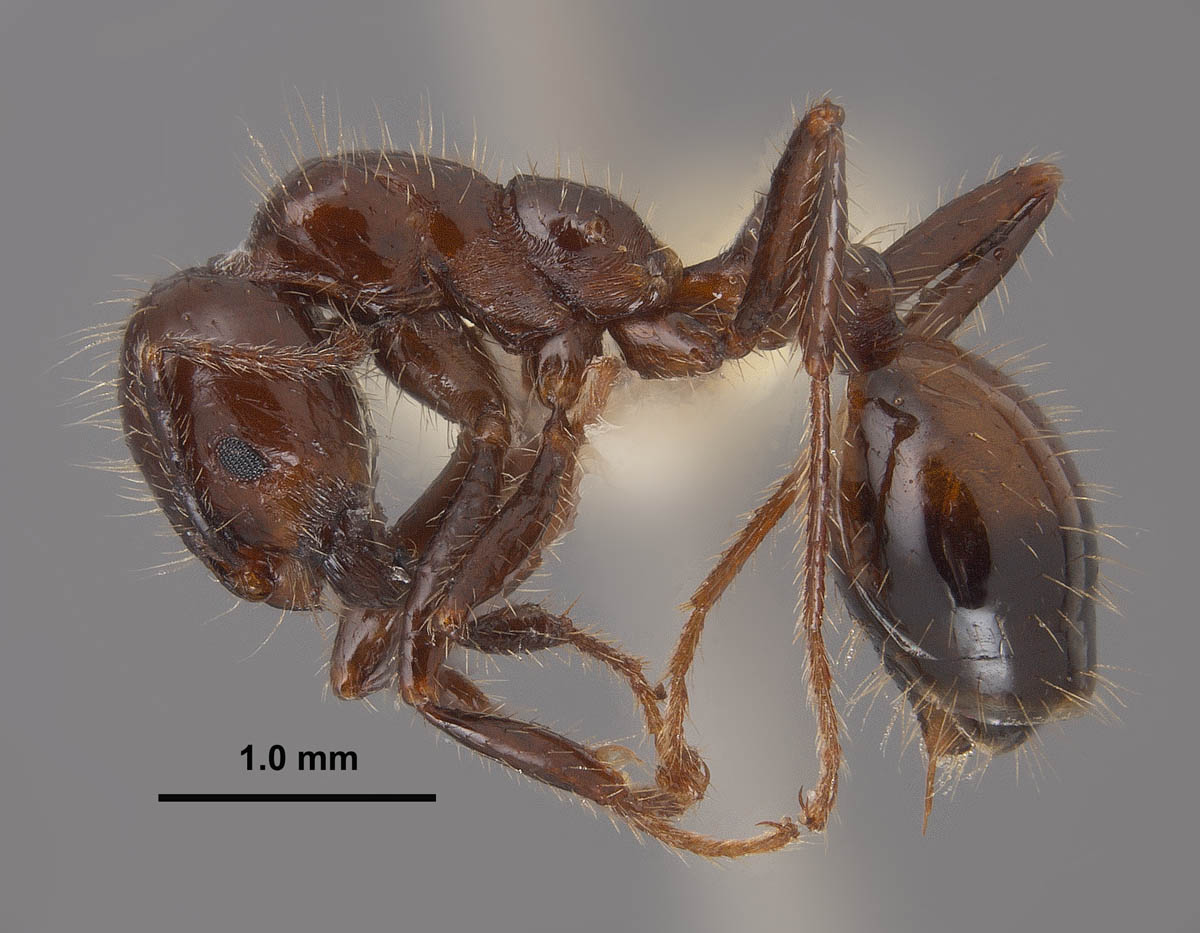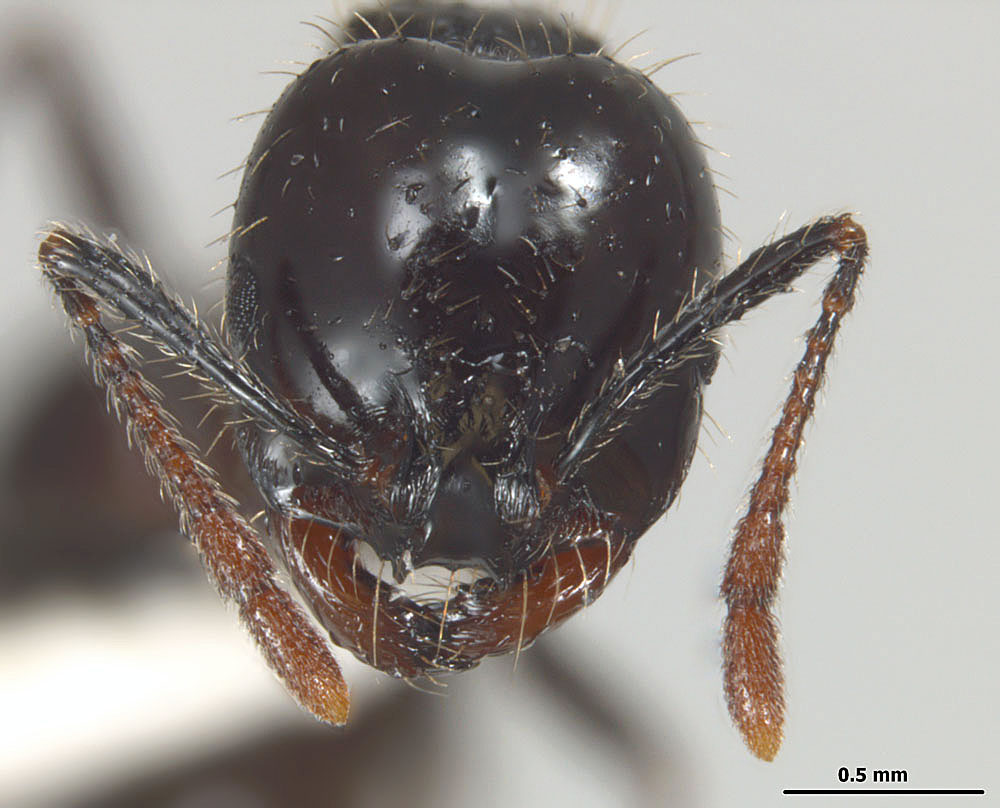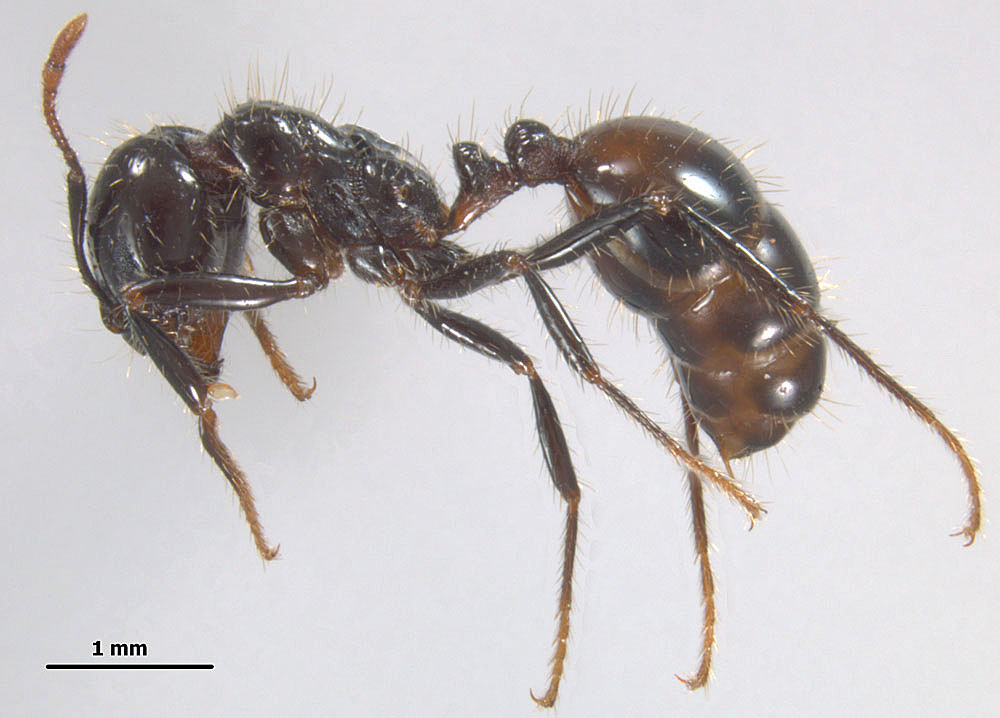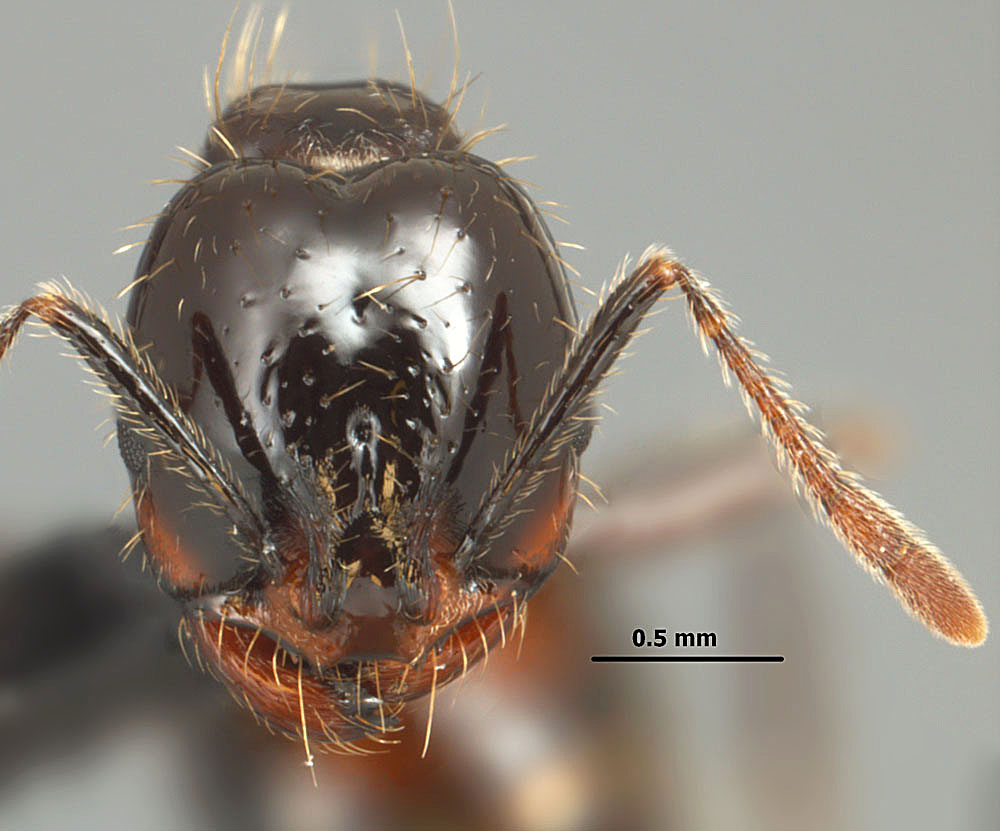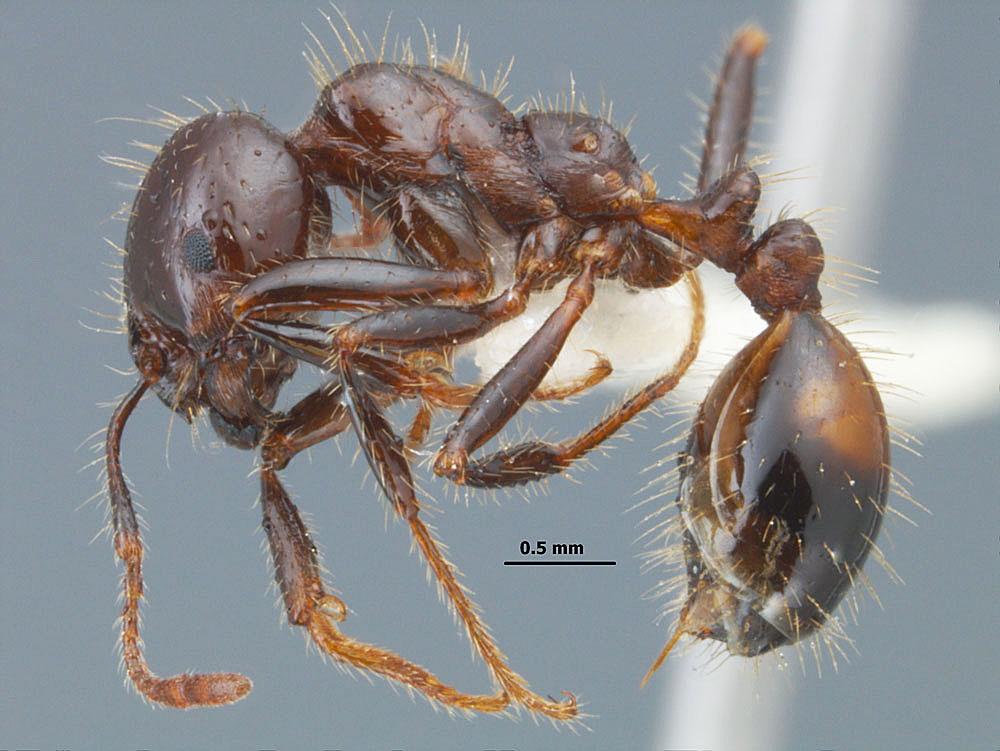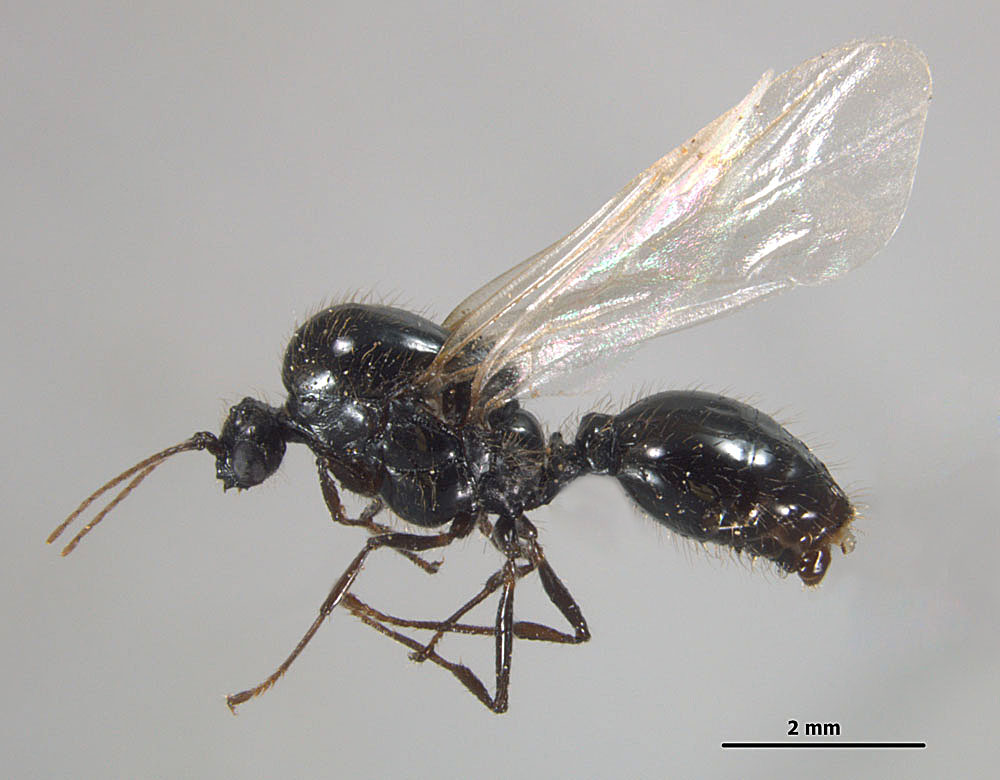Subfamily MYRMICINAE Authors: Joe A. MacGown and Ryan J. Whitehouse |
||
Solenopsis richteri, full face view of a major worker, note the black scapes (MS, Tippah Co.) (photo by Ryan Whitehouse and Joe A. MacGown) |
Solenopsis richteri, lateral view of a major worker, note the black scapes (MS, Tippah Co.) (photo by Ryan Whitehouse and Joe A. MacGown) |
Solenopsis richteri, full face view of a major worker, note the black scapes (MS, Tippah Co.) (photo by Ryan Whitehouse and Joe A. MacGown) |
Solenopsis richteri, clypeal area and mandibles. Note the small medial tooth along clypeal margin (MS, Tippah Co.) (photo by Ryan Whitehouse and Joe A. MacGown) |
Solenopsis richteri, close up of pronotal region (MS, Tippah Co.) (photo by Ryan Whitehouse and Joe A. MacGown) |
Solenopsis richteri, note the humeral bosses of pronotum (MS, Tippah Co.) (photo by Ryan Whitehouse and Joe A. MacGown) |
Solenopsis richteri, full face view of a major worker, note the black scapes (MS) (photo by Joe A. MacGown) |
Solenopsis richteri, profile view of a major worker (MS) (photo by Joe A. MacGown) |
Solenopsis richteri, full face view of a major worker, note the black scapes (MS) (photo by Joe A. MacGown) |
Solenopsis richteri, lateral view of a major worker (MS) (photo by Joe A. MacGown) |
Solenopsis richteri, lateral view of a minor worker (MS) (photo by Joe A. MacGown) |
Solenopsis richteri, lateral view of an alate male (MS) (photo by Joe A. MacGown) |
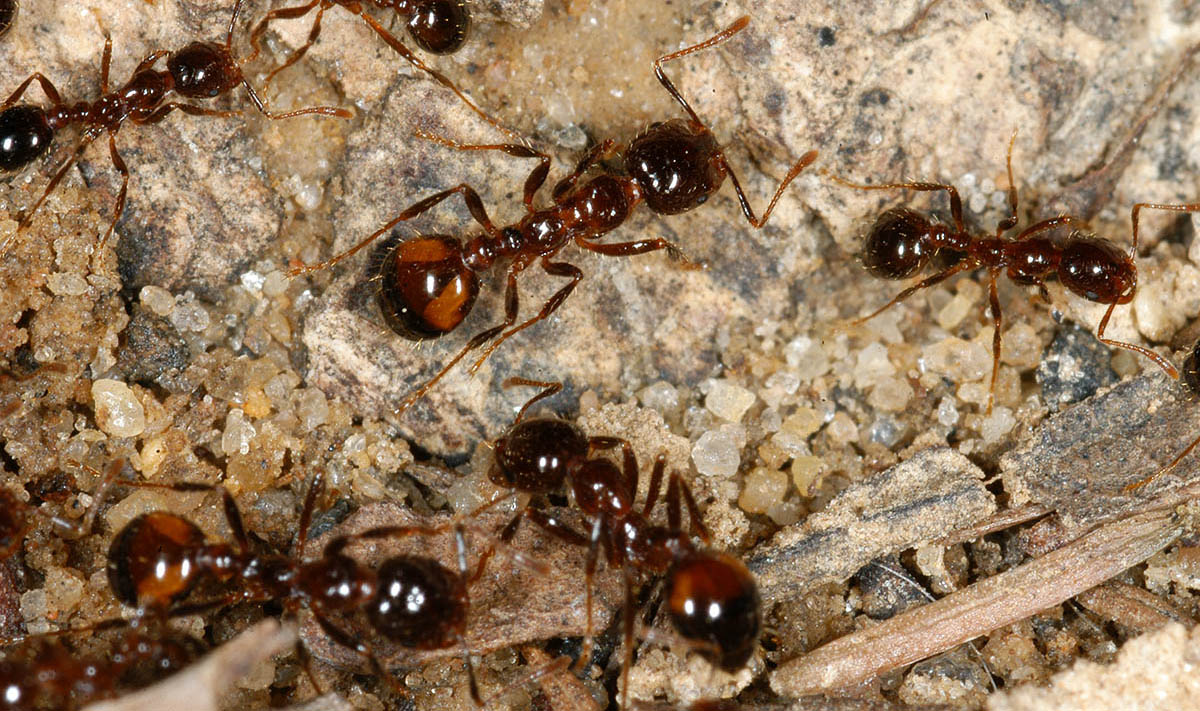 |
||
Solenopsis richteri, workers (MS) (photo by Blake Layton) |
||
Introduction Generic level identification of Solenopsis is relatively straight forward, although sizes are greatly variable ranging from approximately 1.0 mm to over 4.0 mm. The genus can be basically characterized by the following: mandible with four teeth (usually), bicarinate clypeus with 0-5 teeth, median part of clypeus with a pair of longitudinal carinae medially or at lateral edges, 10-segmented antennae that terminates in a distinctive 2-segmented club, overall shiny appearance and general lack of or reduced sculpture (when present usually restricted to rugulae or striae on the head, alitrunk, petiole, and postpetiole), lack of propodeal spines or other protuberances on the alitrunk, well developed petiole and postpetiole, and a well-developed sting. Workers are either polymorphic (especially in the fire ant group) or monomorphic (especially thief ants). Hybridization is not uncommon among the larger fire ant group, which can make identification of some species difficult. Identification of thief ants is perhaps even more challenging due to their minute size, similar appearance of workers of one species to another, taxonomic problems, and lack of knowledge of all castes. Solenopsis richteri, commonly referred to as the black imported fire ant, is a serious econimic pest in both Mississippi and Alabama. This ant can generally be recognized by their large mounds, polymorphic castes (varying sizes of workers), and 10-segmented antennae ending in a 2-segmented club. However, because S. richteri hybridizes with S. invicta, it can be a challenge to differentiate them from the hybrid, which may have characters of both species. The most reliable method for identification of this group is a cuticular hydrocarbon test, which some labs are now equipped to do. Imported fire ants are a major agricultural and urban pest that also causes both medical and environmental harm resulting in a cost of many millions of dollars per year for southeastern states. Taxonomic History (provided by Barry Bolton, 2013) Diagnosis Identification Queen: (Description from Buren 1972). Large, HL 1.25–1.30 mm, HW 1.35–1.40 mm, SL 1.02–1.06 mm. MeSL 2.55– 2.69 mm. Coloration similar to that of workers: Head, scapes, mesosoma, legs, and petiole brownish black; gaster nearly black, but with a bright orange spot on the anterior portion of the first gastric tergite; postpetiole or the rear portion of it usually the same color as the gastral spot. Head about as wide as long, rounded square; smooth and shining with scatterred erect setae; posterior margin median with a crease-like excision; eyes large and situated laterally at the midpoint of the head; three ocelli present; antennae 11-segmented with a 2-segmented club; scapes slightly exceed posterior margin of head; clypeus tridentate, median tooth minute, with two anteriorly diverging carinae; mandibles with 4 teeth. Mesosoma rounded rectangular, almost square, with mesoscutum rounded anteriorly; mostly mooth and shining except some striae present on anterior portion of mesoscutellum and propodeum with numerous transverse striae; numerous erect setae present dorsally and on propodeum, but sparse on pronotum and mesopleura; dorsal surface relatively flat; four wings or wing scars present; propodeum unarmed; declivity straight, almost 90°. Wings clear with light amber colored viens; forewing with costal, basal, subbasal, submarginal, and discal cells presesnt, pterostigma present; hindwing with costal, basal, and anal cells present. Waist 2-segmented, anterior faces of petiole and postpetiole with moderately dense, appressed pubescence; erect hairs numerous and present on all surfaces; petiolar node narrower than the postpetiolar node in lateral view; sides of petiole finely punctate and roughened. Gaster shining with long erect setae; sting present. Male: (Description from Buren 1972 and MEM specimen). Medium sized, about the size of large worker (HL 0.76–0.84 mm, HW 1.02–1.06 mm, MeSL 2.60–2.69 mm. Entire body black except funiculus, which is yellowish brown to reddish brown; wings transparent. Head small compared to the mesosoma, circular; shiny with course rugae anteriorly fading to dense punctation posteriorly, clypeus mostly lacking sculpture; with numerous long, erect, whitesh colored setae present; eyes large, more than twice the head length, located on the anterior half of the head; three large ocelli present; frontal carina reduced; antennae 12-segmented, scape short, subequal to antennae segments 3-12; second antennal segment (pedicel) short, ovoid; clypeus without trace of carinae; mandibles small, with 2 teeth. Mesosoma bulky, elliptical in lateral view; mostly mooth and shining except some striae present on anterior portion of mesoscutellum and propodeum with dense punctation; entire mesosoma with numerous erect, elongate, whitesh setae present; propodeum unarmed. Wings clear with light amber colored viens; forewing with costal, basal, subbasal, submarginal, and discal cells presesnt, pterostigma present; hindwing with costal, basal, and anal cells present. Waist 2-segmented, both nodes with dense, fine punctation; petiolar node with a dorsal median notch. Gaster shiniy, with numerous erect, light colored, elongate setae, especially posterially genitalia visible at the apex. Biology Pest Status Distribution Nearctic: United States (antweb.org, antwiki.org, and MEM). U.S. Distribution: AL, AR, MS, NC, TN, VA (antweb.org, antwiki.org, and MEM). Species Distribution Map Acknowledgments Literature Cited Buren, W. F. 1972. Revisionary studies on the taxonomy of the imported fire ants. Journal of the Georgia Entomological Society 7:1-26. Creighton, W. S. 1930. The New World species of the genus Solenopsis (Hymenop. Formicidae). Proceedings of the American Academy of Arts and Sciences 66:39-151. Creighton, W. S. 1950. The ants of North America. Bulletin of the Museum of Comparative Zoology 104:1-585. Forel, A. 1909. Ameisen aus Guatemala usw., Paraguay und Argentinien (Hym.). Deutsche Entomologische Zeitschrift 1909:239-269. Rhoades, R. B. 1977. Medical aspects of the imported fire ant. Gainesville: University of Florida Press, 75 pp. Santschi, F. 1916. Formicides sudaméricains nouveaux ou peu connus. Physis (Buenos Aires) 2:365-399. Taber, S. 2000. Fire Ants. College Station TX: Texas A&M University Press. Trager, J. C. 1991. A revision of the fire ants, Solenopsis geminata group (Hymenoptera: Formicidae: Myrmicinae). Journal of the New York Entomological Society 99:141-198. Wheeler, G. C.; Wheeler, J. 1977. Supplementary studies on ant larvae: Myrmicinae. Transactions of the American Entomological Society 103:581-602. Wilson, E. O. 1952. O complexo Solenopsis saevissima na America do Sul (Hymenoptera: Formicidae). Memórias do Instituto Oswaldo Cruz. Rio de Janeiro 50:49-59. Links
AntWeb |
||


